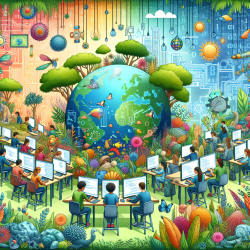Introduction
In the quest for sustainable environmental solutions, educators and practitioners face the challenge of integrating interdisciplinary thought processes. The research article "Computational Thinking to Learn Environmental Sustainability: A Learning Progression" provides insights into leveraging computational thinking (CT) to enhance environmental science education. This blog explores the outcomes of this research and offers guidance for practitioners seeking to improve their skills and understanding of environmental sustainability through CT.
The Role of Computational Thinking in Environmental Education
Computational thinking is increasingly recognized as a crucial component of modern science curricula. It involves problem-solving methods that formulate solutions executable by computers. In environmental science, CT supports the development of skills necessary for interdisciplinary sustainable solutions. The research highlights the need for a learning progression that integrates CT with environmental science, emphasizing the spheres of sustainability, research, education, and economic perspectives.
Implementing Computational Thinking in Practice
Practitioners can enhance their teaching and research by incorporating CT into their environmental science programs. Here are some strategies:
- Scaffold Learning: Develop a learning progression that gradually introduces students to computational tools and concepts, starting from simple to complex applications.
- Interdisciplinary Approach: Encourage students to explore the intersections of environmental, economic, and social spheres, using CT to analyze and propose solutions to real-world problems.
- Utilize Technology: Incorporate advanced technologies and data management practices to facilitate hands-on learning experiences and enhance students' understanding of environmental systems.
- Promote Critical Thinking: Use CT to foster critical thinking skills, enabling students to evaluate claims, analyze data, and develop evidence-based arguments.
Encouraging Further Research
The integration of CT in environmental education is still an emerging field, with ample opportunities for further research. Practitioners are encouraged to explore the following areas:
- Assessment and Evaluation: Develop methods to assess students' computational skills and their ability to apply these skills to environmental challenges.
- Curriculum Development: Design curricula that effectively integrate CT with environmental science, ensuring alignment with educational standards and learning objectives.
- Collaboration and Networking: Engage with other educators, researchers, and industry professionals to share best practices and collaborate on innovative projects.
Conclusion
By embracing computational thinking, educators and practitioners can significantly enhance the teaching and learning of environmental science. This interdisciplinary approach not only equips students with the skills needed to tackle complex environmental issues but also fosters a deeper understanding of sustainability. As the field continues to evolve, ongoing research and collaboration will be essential in refining and expanding the integration of CT in environmental education.
To read the original research paper, please follow this link: Computational Thinking to Learn Environmental Sustainability: A Learning Progression.










